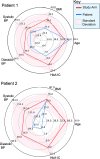Semantically enabling clinical decision support recommendations
- PMID: 37464259
- PMCID: PMC10353186
- DOI: 10.1186/s13326-023-00285-9
Semantically enabling clinical decision support recommendations
Abstract
Background: Clinical decision support systems have been widely deployed to guide healthcare decisions on patient diagnosis, treatment choices, and patient management through evidence-based recommendations. These recommendations are typically derived from clinical practice guidelines created by clinical specialties or healthcare organizations. Although there have been many different technical approaches to encoding guideline recommendations into decision support systems, much of the previous work has not focused on enabling system generated recommendations through the formalization of changes in a guideline, the provenance of a recommendation, and applicability of the evidence. Prior work indicates that healthcare providers may not find that guideline-derived recommendations always meet their needs for reasons such as lack of relevance, transparency, time pressure, and applicability to their clinical practice.
Results: We introduce several semantic techniques that model diseases based on clinical practice guidelines, provenance of the guidelines, and the study cohorts they are based on to enhance the capabilities of clinical decision support systems. We have explored ways to enable clinical decision support systems with semantic technologies that can represent and link to details in related items from the scientific literature and quickly adapt to changing information from the guidelines, identifying gaps, and supporting personalized explanations. Previous semantics-driven clinical decision systems have limited support in all these aspects, and we present the ontologies and semantic web based software tools in three distinct areas that are unified using a standard set of ontologies and a custom-built knowledge graph framework: (i) guideline modeling to characterize diseases, (ii) guideline provenance to attach evidence to treatment decisions from authoritative sources, and (iii) study cohort modeling to identify relevant research publications for complicated patients.
Conclusions: We have enhanced existing, evidence-based knowledge by developing ontologies and software that enables clinicians to conveniently access updates to and provenance of guidelines, as well as gather additional information from research studies applicable to their patients' unique circumstances. Our software solutions leverage many well-used existing biomedical ontologies and build upon decades of knowledge representation and reasoning work, leading to explainable results.
Keywords: Data Integration; Disease Characterization; Guideline Modeling; Knowledge Representation.
© 2023. The Author(s).
Conflict of interest statement
The authors declare that they have no competing interests.
Figures










References
-
- Chari S, Qi M, Agu NN, Seneviratne O, McCusker JP, Bennett KP, et al. Enabling trust in clinical decision support recommendations through semantics. Semantic web solutions for large-scale biomedical data analytics workshop at the International Semantic Web Conference. 2019. https://ceur-ws.org/Vol-2477/paper_5.pdf.
-
- Hasnain A, Novacek V, Dumontier M, Rebholz-Schuhmann D. Semantic Web solutions for large-scale biomedical data analytics (SeWeBMeDA-2019), Workshop at ISWC 2019, 27th October Auckland New Zealand. 2019. https://sites.google.com/view/sewebmeda-2019. Accessed 22 Apr 2021.
-
- Fox J, Johns N, Rahmanzadeh A, Thomson R. PROforma: a method and language for specifying clinical guidelines and protocols. Studies in Health Technology and Informatics. 1996. p. 516–20. https://ebooks.iospress.nl/doi/10.3233/978-1-60750-878-6-516. - DOI
Publication types
MeSH terms
LinkOut - more resources
Full Text Sources

